BE279 Applied Statistics and Forecasting Sample
Topic 1
1. Introduction
In every organization, to expand the business and implement the job needs the support of the worker. For this the organization should move forward. Moreover the organization needs to [pay the salary on their time . For this the worker should didi their work on time . In this case study reader should find the salary protocall of the organization.
2. Methodology and data
The study discusses this and other surveys involving information from the Association for information study system Survey of salary ,rank, distribution information and comparable information related to recruitmentnews from MIS Faculty. This review had three main findings. For starters academic and personal variables have an impact on the position and salary offered but individual factors has more lasting effects. Second This research should look for placements presented by schools that to some extent interfere with the association between school , individual factors and initial salary.The last is the immediate effects of individual items are also influenced by certain field factors . In which, the distribution at the highest level is the main variable of the individual to determine the remuneration of the doctoral degree institutions.
Fascinatingly, scholars of various level are offered others see on the employee compensation of MIS,which often. Employees who approach their school during recruitment are first asked to list institutional or external factors, for example, if the classes is organized for research or focused on education, whether one or social , whether he has a “doctoral program” or not, whether he is a for affiliation reasons, and may this be a good year for MIS. By all accounts, agreement seems to be that single qualities, particularly a competitor’s track record in distributing A-grade articles, may be important, but those qualities are crucial. compensate them. When asked, employees generally agree that work-related items will also affect pay, but it is generally felt that single items (e.g. “experience, Level distribution”) will drive placement distribution. Similarly, argues that although collectivism is the main model when assessing a potential competitor in the workforce at the associate teacher level,
3. Analysis and results (including robustness analysis)
| Statistics | |||
| salary | female | ||
| N | Valid | 786 | 753 |
| “Missing” | 0 | 33 | |
| “Mean” | .08 | ||
| “Median” | .00 | ||
| “Mode” | 0 | ||
| “Std. Deviation” | .277 | ||
| “Variance” | .077 | ||
Table 1 Statistics
(Source : SPSS)
| female | |||||
| “Frequency” | “Percent” | “Valid Percent” | “Cumulative Percent” | ||
| “Valid” | 0 | 690 | 87.8 | 91.6 | 91.6 |
| 1 | 63 | 8.0 | 8.4 | 100.0 | |
| Total | 753 | 95.8 | 100.0 | ||
| “Missing” | “System” | 33 | 4.2 | ||
| Total | 786 | 100.0 | |||
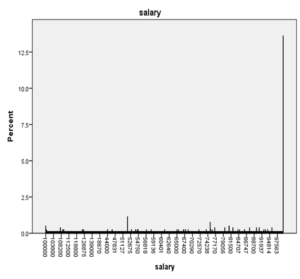
Figure 1 Salary stat
(Source : SPSS)
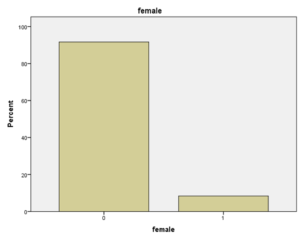
Figure 2 Employ stat
(Source : SPSS)
| Statistics | |||||
| V1 | salary | female | lsalary | ||
| N | Valid | 786 | 786 | 753 | 786 |
| Missing | 0 | 0 | 33 | 0 | |
| Mean | 393.50 | .08 | |||
| Median | 393.50 | .00 | |||
| Mode | 1a | 0 | |||
| Std. Deviation | 227.043 | .277 | |||
| Variance | 51548.500 | .077 | |||
| “a. Multiple modes exist. The smallest value is shown” | |||||
Table 3 Statistics
(Source : SPSS)
Anova Test –
Table 4 Anova
(Source : SPSS)
“T-test”
| “Group Statistics” | |||||
| female | N | “Mean” | “Std. Deviation” | “Std. Error Mean” | |
| V1 | >= 3 | 0a | . | . | . |
| < 3 | 753 | 380.01 | 221.802 | 8.083 | |
| id | >= 3 | 0a | . | . | . |
| < 3 | 753 | 527.78 | 253.154 | 9.225 | |
| pubindx | >= 3 | 0a | . | . | . |
| < 3 | 753 | 36.901806128511865 | 39.034539508677790 | 1.422497697972276 | |
| totpge | >= 3 | 0a | . | . | . |
| < 3 | 744 | 161.608488453331800 | 146.667395247874540 | 5.377087595199336 | |
| a. t “cannot be computed because at least one of the groups is empty.”
Table 5 T-test (Source : SPSS)
|
|||||
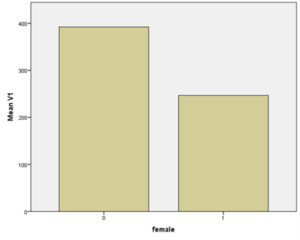
Figure 3 Employe stat
(Source : SPSS)
“Regression”
| “Descriptive Statistics” | |||
| “Mean” | “Std. Deviation” | N | |
| id | 527.78 | 253.154 | 753 |
| female | .08 | .277 | 753 |
Table 6 Descriptive stat
(Source : SPSS)
| “Correlations” | |||
| id | female | ||
| “Pearson Correlation” | id | 1.000 | -.182 |
| female | -.182 | 1.000 | |
| “Sig. (1-tailed)” | id | . | .000 |
| female | .000 | . | |
| N | id | 753 | 753 |
| female | 753 | 753 | |
Table 6 Correlation
(Source : SPSS)
| “Variables Entered/Removed” | |||
| “Model” | “Variables Entered” | “Variables Removed” | “Method” |
| 1 | female | . | “Stepwise (Criteria: Probability-of-F-to-enter <= .050, Probability-of-F-to-remove >= .100)”. |
| a. “Dependent Variable”: id | |||
Table 7: Variables
(Source : SPSS)
| “Model Summary” | ||||
| “Model” | R | “R Square” | “Adjusted R Square” | “Std. Error of the Estimate” |
| 1 | .182a | .033 | .032 | 249.109 |
| a. Predictors: (Constant), female | ||||
Table 8: Variables
(Source : SPSS)
| “ANOVA”a | ||||||
| Model | “Sum of Squares” | df | “Mean Square” | F | Sig. | |
| 1 | “Regression” | 1589925.629 | 1 | 1589925.629 | 25.621 | .000b |
| Residual | 46603647.518 | 751 | 62055.456 | |||
| Total | 48193573.147 | 752 | ||||
| a. “Dependent Variable”: id | ||||||
| b. “Predictors: (Constant), female” | ||||||
Table 9: Annova
(Source : SPSS)
| “Coefficients” | ||||||
| Model | “Unstandardized Coefficients” | “Standardized Coefficients” | t | Sig. | ||
| B | “Std. Error” | “Beta” | ||||
| 1 | (“Constant”) | 541.670 | 9.483 | 57.117 | .000 | |
| female | -165.955 | 32.786 | -.182 | -5.062 | .000 | |
| a. Dependent Variable: id | ||||||
Table 10 : Coefficient
(Source : SPSS)
“T-Test”
| “Paired Samples Statistics” | |||||
| “Mean” | N | “Std. Deviation” | “Std. Error Mean” | ||
| Pair 1 | V1 | 380.01 | 753 | 221.802 | 8.083 |
| female | .08 | 753 | .277 | .010 | |
| Pair 2 | id | 542.85 | 786 | 258.603 | 9.224 |
| y99 | .33 | 786 | .472 | .017 | |
Table 11 :”Paired sample test”
(Source : SPSS)
| “Paired Samples Correlations” | ||||
| N | “Correlation” | Sig. | ||
| Pair 1 | V1 & female | 753 | -.182 | .000 |
| Pair 2 | id & y99 | 786 | .000 | 1.000 |
Table 12 :”Paired sample test”
(Source : SPSS)
| “Paired Samples Test” | |||||||||
| “Paired Differences” | t | df | “Sig. (2-tailed)” | ||||||
| “Mean” | “Std. Deviation” | “Std. Error Mean” | “95% Confidence Interval of the Difference” | ||||||
| “Lower” | “Upper” | ||||||||
| Pair 1 | V1 – female | 379.928 | 221.853 | 8.085 | 364.057 | 395.800 | 46.993 | 752 | .000 |
| Pair 2 | id – y99 | 542.514 | 258.603 | 9.224 | 524.407 | 560.621 | 58.815 | 785 | .000 |
Table 13 :”Paired sample test”
(Source : SPSS)
PPlot
| “Model Description” | ||
| “Model Name” | MOD_1 | |
| “Series or Sequence” | 1 | V1 |
| 2 | id | |
| 3 | pubindx | |
| 4 | totpge | |
| “Transformation” | None | |
| “Non-Seasonal Differencing” | 0 | |
| “Seasonal Differencing” | 0 | |
| “Length of Seasonal Period” | No periodicity | |
| “Standardization” | Not applied | |
| “Distribution” | Type | Normal |
| Location | estimated | |
| Scale | estimated | |
| “Fractional Rank Estimation Method” | Blom’s | |
| “Rank Assigned to Ties” | “Mean rank of tied values” | |
| “Applying the model specifications from MOD_1” | ||
Table 14 :”P-plot”
(Source : SPSS)
| “Case Processing Summary” | |||||
| V1 | id | pubindx | totpge | ||
| Series or Sequence Length | 786 | 786 | 786 | 786 | |
| “Number of Missing Values in the Plot” | “User-Missing | 0 | 0 | 0 | 0 |
| System-Missing” | 0 | 0 | 0 | 39 | |
| “The cases are unweighted.”
Table 15:”P-plot” (Source : SPSS) |
|||||
| “Estimated Distribution Parameters” | |||||
| V1 | id | pubindx | totpge | ||
| Normal Distribution | Location | 393.500000000000000 | 542.847328244274800 | 35.352493657467480 | 160.959458379222070 |
| Scale | 227.042947479105800 | 258.602776029033900 | 38.916367705071906 | 146.729089572200650 | |
| The cases are unweighted.
Table 16 :”P-plot” (Source : SPSS) |
|||||
V1
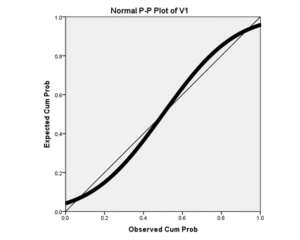
“Figure 4 P-plot”
“(Source : SPSS)”
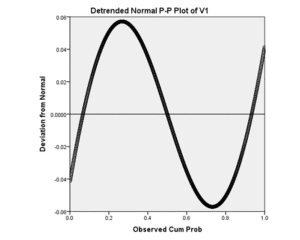
“Figure 5 P-plot”
“(Source : SPSS)”
id
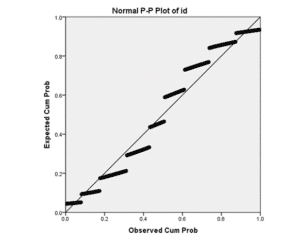
Figure 6 P-plot
(Source : SPSS)

Figure 7 P-plot
(Source : SPSS)
pubindx
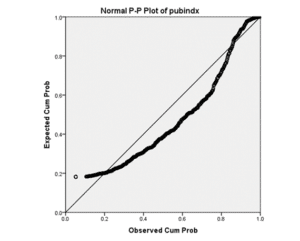
“Figure 8 P-plot”
“(Source : SPSS)”
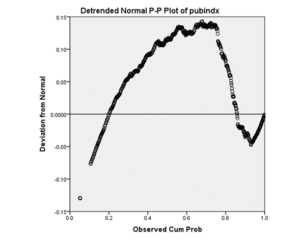
“Figure 9 P-plot”
“(Source : SPSS)”
totpge
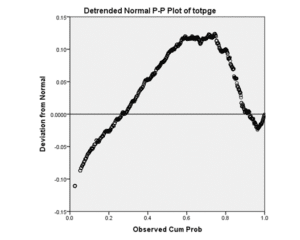
“Figure 10 P-plot”
“(Source : SPSS)”
4. Discussion and conclusions
Organizations could recruit a new workforce as learning partners (regardless of residency) to legitimize pay commensurate with their capabilities or, potentially, an organization could offer better compensation. rank (and place of residence) to balance a rather lower salary or a higher educational burden. Therefore, the ability to adapt to the idea of a position can be an advantage for both the candidate and the organization, but just like the ability to reshape the position. Finally, institutionally, this is certainly one method by which platforms can attract attractive people. For example, find a central school looking to attract qualified and motivated junior staff to strengthen its exam. for example, the widely held view in the field that “private organizations” pay more. In any case, if so, people suggest that “MIS professionals” could profit from a reasonable investigation of the variables that affect their own compensation, and they could be quite shocked by the results. of such an examination.
In the end of the research some findings also suggest that employees who are looking for work and those trying to hire them may need to do their homework before engaging in interactions by visiting the AIS site and reading the Teacher’s report. monk Galleta. The doctoral project headquarters and facilitators may also want to encourage their PhD students to focus on reporting as well as completing research when the opportunity arises.
Topic 2
1. Introduction
Contingency plans are knowledgeable in reiterating the testing conditions faced by the region . These constraints are monetary , political , administrative , legal , innovative and social . As a result of stress the company faces increasing competition , stunted growth and abundant capital , and extended connections. The operation of gadgets in home and work environments, the improvement of autonomous vehicles and the growing threats of digital attacks are changing the way people live and take advantage of their opportunities. Contingency plans must support their action plans in the face of developments that may threaten the company’s growth. Progress is considered by many to be the single greatest success in a deeply global and fierce economy. The growth perspective paints a big picture of future opportunities which give some growth to the organization. The reason for the case study is to know the relation between the possibility of promotion, the type of promotion and different parts of the business including the marketing , development and currency exposure. Focus of an observational assessment of teh protectionist industry in the UK . Observational verification of these models and the evidence to confirm the relation between the development possibilities.
2. Methodology and data
The exploration is oriented in the field of protection given teh fact that protection operations are growing and the information base is inactive.Invented devices are essential to ensure agents protection in difficult working environment.Protected cases can be classified as life. In additional articles on protection . Th commercial and non life insurance deals specifically current and long term theoretical bets. Many insurers are facing , the difficulties due to the large increase in the number of customers who are buying personalized and the lack of service . The gradual improvement of innovation which change in ;large scale. The economy and the industry are facing productive and innovative competitors inside and outside of teh company.Then given the importance of advance protection it is the focus of research in the UK. The research gives knowledge on this topic . For this the structures shou;ld make a clear view on the reader’s mind.
3. Analysis and results (including robustness analysis)
Means
Table 17 : “Mean”
(Source : SPSS)
| Innovation goods Innovation logistics Cooperation size of company (staff) * Innovation services | |||||
| Innovation services | Innovation goods | Innovation logistics | Cooperation | size of company (staff) | |
| 0 | Mean | .36 | .08 | .24 | 145.54 |
| Std. Deviation | .481 | .269 | .426 | 483.458 | |
| Median | .00 | .00 | .00 | 44.00 | |
| Std. Error of Mean | .007 | .004 | .006 | 7.309 | |
| 1 | Mean | .82 | .33 | .54 | 329.92 |
| Std. Deviation | .384 | .472 | .498 | 979.729 | |
| Median | 1.00 | .00 | 1.00 | 92.00 | |
| Std. Error of Mean | .016 | .020 | .021 | 41.890 | |
| Total | Mean | .42 | .11 | .27 | 166.03 |
| Std. Deviation | .493 | .309 | .445 | 563.569 | |
| Median | .00 | .00 | .00 | 46.00 | |
| Std. Error of Mean | .007 | .004 | .006 | 8.033 | |
Table 18:”Mean”
(Source : SPSS)
Table 19:”Mean”
(Source : SPSS)
| Innovation goods Innovation logistics Cooperation size of company (staff) * Innovation support | |||||
| Innovation support | Innovation goods | Innovation logistics | Cooperation | size of company (staff) | |
| 0 | Mean | .35 | .04 | .21 | 136.61 |
| Std. Deviation | .477 | .198 | .405 | 489.855 | |
| Median | .00 | .00 | .00 | 39.00 | |
| Std. Error of Mean | .008 | .003 | .006 | 7.823 | |
| 1 | Mean | .67 | .37 | .53 | 281.30 |
| Std. Deviation | .472 | .482 | .500 | 778.220 | |
| Median | 1.00 | .00 | 1.00 | 93.00 | |
| Std. Error of Mean | .015 | .015 | .016 | 24.597 | |
| Total | Mean | .42 | .11 | .27 | 166.03 |
| Std. Deviation | .493 | .309 | .445 | 563.569 | |
| Median | .00 | .00 | .00 | 46.00 | |
| Std. Error of Mean | .007 | .004 | .006 | 8.033 | |
Table 20:”Mean”
(Source : SPSS)
“Descriptives”
| “Descriptive Statistics” | |||||
| N | “Minimum” | “Maximum” | “Mean” | “Std. Deviation” | |
| Innovation goods | 4922 | 0 | 1 | .42 | .493 |
| Innovation services | 4922 | 0 | 1 | .11 | .314 |
| Innovation support | 4922 | 0 | 1 | .20 | .403 |
| Valid N (listwise) | 4922 | ||||
Table 21:“Descriptive Statistics”
(Source : SPSS)
T-Test
| “One-Sample Statistics” | ||||
| N | “Mean” | “Std. Deviation” | “Std. Error Mean” | |
| size of company (staff) | 4922 | 166.03 | 563.569 | 8.033 |
Table 22:“One-Sample Statistics”
(Source : SPSS)
| “One-Sample Test” | ||||||
| “Test Value = 0” | ||||||
| t | df | “Sig. (2-tailed)” | “Mean Difference” | “95% Confidence Interval of the Difference” | ||
| “Lower” | “Upper” | |||||
| size of company (staff) | 20.669 | 4921 | .000 | 166.033 | 150.29 | 181.78 |
Table 23:“One-Sample Statistics”
(Source : SPSS)
“Oneway”
Table 24:“One-way Statistics”
(Source : SPSS)
| ANOVA | ||||||
| “Sum of Squares” | df | “Mean Square” | F | Sig. | ||
| Innovation goods | “Between Groups” | 174.502 | 1 | 174.502 | 841.166 | .000 |
| Within Groups | 1020.669 | 4920 | .207 | |||
| Total | 1195.171 | 4921 | ||||
| Innovation services | Between Groups | 29.109 | 1 | 29.109 | 313.317 | .000 |
| Within Groups | 457.101 | 4920 | .093 | |||
| Total | 486.210 | 4921 | ||||
| Innovation support | Between Groups | 105.744 | 1 | 105.744 | 752.170 | .000 |
| Within Groups | 691.680 | 4920 | .141 | |||
| Total | 797.424 | 4921 | ||||
| Cooperation | Between Groups | 132.035 | 1 | 132.035 | 771.288 | .000 |
| Within Groups | 842.242 | 4920 | .171 | |||
| Total | 974.277 | 4921 | ||||
Table 25:“One-way Statistics”
(Source : SPSS)
Means Plots
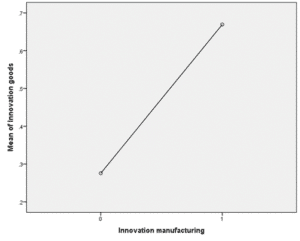
Figure 11 Mean-plot
(Source : SPSS)
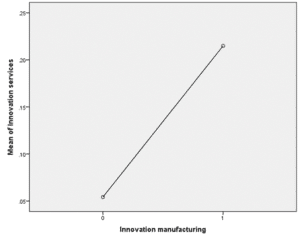
Figure 12 Mean-plot
(Source : SPSS)
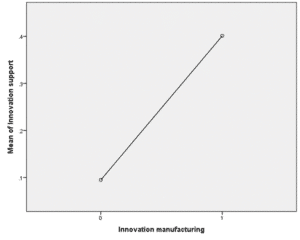
Figure 13 Mean-plot
(Source : SPSS)
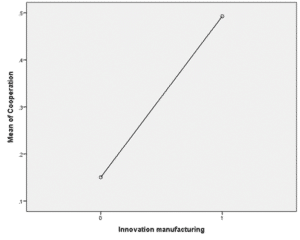
Figure 14 Mean-plot
(Source : SPSS)
“Regression”
| “Descriptive Statistics” | |||
| Mean | Std. Deviation | N | |
| size of company (staff) | 166.03 | 563.569 | 4922 |
| Innovation goods | .42 | .493 | 4922 |
| Innovation services | .11 | .314 | 4922 |
| Innovation manufacturing | .35 | .478 | 4922 |
| Innovation logistics | .11 | .309 | 4922 |
| Innovation support | .20 | .403 | 4922 |
Table 26: “Regression”
(Source : SPSS)
Table 27: “Regression”
(Source : SPSS)
| “Variables Entered/Removeda” | |||
| Model | “Variables Entered” | “Variables Removed” | “Method” |
| 1 | Innovation logistics | . | “Stepwise (Criteria: Probability-of-F-to-enter <= .050, Probability-of-F-to-remove >= .100).” |
| 2 | Innovation services | . | “Stepwise (Criteria: Probability-of-F-to-enter <= .050, Probability-of-F-to-remove >= .100)”. |
| 3 | Innovation support | . | “Stepwise (Criteria: Probability-of-F-to-enter <= .050, Probability-of-F-to-remove >= .100).” |
| 4 | Innovation manufacturing | . | “Stepwise (Criteria: Probability-of-F-to-enter <= .050, Probability-of-F-to-remove >= .100)”. |
| a. “Dependent Variable”: size of company (staff) | |||
Table 27: “Regression”
(Source : SPSS)
| Model Summarye | ||||
| Model | R | “R Square” | “Adjusted R Square” | “Std. Error of the Estimate” |
| 1 | .114a | .013 | .013 | 559.962 |
| 2 | .137b | .019 | .018 | 558.386 |
| 3 | .145c | .021 | .020 | 557.808 |
| 4 | .149d | .022 | .021 | 557.501 |
| a.” Predictors: (Constant), Innovation logistics” | ||||
| b. Predictors: (Constant), Innovation logistics, Innovation services | ||||
| c. Predictors: (Constant), Innovation logistics, Innovation services, Innovation support | ||||
| d. Predictors: (Constant), Innovation logistics, Innovation services, Innovation support, Innovation manufacturing | ||||
| e. Dependent Variable: size of company (staff) | ||||
Table 28: “Regression”
(Source : SPSS)
| “ANOVAa” | ||||||
| Model | “Sum of Squares” | df | “Mean Square” | F | Sig. | |
| 1 | “Regression” | 20254653.523 | 1 | 20254653.523 | 64.596 | .000b |
| “Residual” | 1542704433.012 | 4920 | 313557.812 | |||
| Total | 1562959086.536 | 4921 | ||||
| 2 | Regression | 29242024.723 | 2 | 14621012.362 | 46.893 | .000c |
| Residual | 1533717061.812 | 4919 | 311794.483 | |||
| Total | 1562959086.536 | 4921 | ||||
| 3 | Regression | 32722619.079 | 3 | 10907539.693 | 35.056 | .000d |
| Residual | 1530236467.457 | 4918 | 311150.156 | |||
| Total | 1562959086.536 | 4921 | ||||
| 4 | Regression | 34717824.501 | 4 | 8679456.125 | 27.925 | .000e |
| Residual | 1528241262.035 | 4917 | 310807.660 | |||
| Total | 1562959086.536 | 4921 | ||||
| a. “Dependent Variable”: size of company (staff) | ||||||
| b. “Predictors: (Constant), Innovation logistics” | ||||||
| c. “Predictors: (Constant), Innovation logistics”, Innovation services | ||||||
| d. Predictors: (Constant), Innovation logistics, Innovation services, Innovation support | ||||||
| e. Predictors: (Constant), Innovation logistics, Innovation services, Innovation support, Innovation manufacturing | ||||||
Table 29: “Anova”
(Source : SPSS)
| Coefficientsa | ||||||
| Model | “Unstandardized Coefficients” | “Standardized Coefficients” | t | Sig. | ||
| B | Std. Error | Beta | ||||
| 1 | (Constant) | 143.820 | 8.447 | 17.027 | .000 | |
| Innovation logistics | 207.467 | 25.813 | .114 | 8.037 | .000 | |
| 2 | (Constant) | 132.158 | 8.698 | 15.193 | .000 | |
| Innovation logistics | 170.234 | 26.659 | .093 | 6.386 | .000 | |
| Innovation services | 140.806 | 26.226 | .079 | 5.369 | .000 | |
| 3 | (Constant) | 122.849 | 9.124 | 13.464 | .000 | |
| Innovation logistics | 133.708 | 28.783 | .073 | 4.645 | .000 | |
| Innovation services | 123.746 | 26.691 | .069 | 4.636 | .000 | |
| Innovation support | 74.324 | 22.222 | .053 | 3.345 | .001 | |
| 4 | (Constant) | 111.594 | 10.144 | 11.001 | .000 | |
| Innovation logistics | 119.219 | 29.330 | .065 | 4.065 | .000 | |
| Innovation services | 114.888 | 26.905 | .064 | 4.270 | .000 | |
| Innovation support | 60.761 | 22.846 | .043 | 2.660 | .008 | |
| Innovation manufacturing | 46.681 | 18.424 | .040 | 2.534 | .011 | |
| a. “Dependent Variable”: size of company (staff) | ||||||
Table 30: “Coefficient”
(Source : SPSS)
| “Excluded Variables”a | ||||||
| Model | Beta In | t | Sig. | “Partial Correlation” | “Collinearity Statistics” | |
| Tolerance | ||||||
| 1 | Innovation goods | .059b | 4.056 | .000 | .058 | .959 |
| Innovation services | .079b | 5.369 | .000 | .076 | .932 | |
| Innovation manufacturing | .062b | 4.116 | .000 | .059 | .887 | |
| Innovation support | .067b | 4.301 | .000 | .061 | .820 | |
| 2 | Innovation goods | .042c | 2.799 | .005 | .040 | .898 |
| Innovation manufacturing | .049c | 3.245 | .001 | .046 | .860 | |
| Innovation support | .053c | 3.345 | .001 | .048 | .790 | |
| 3 | Innovation goods | .035d | 2.316 | .021 | .033 | .877 |
| Innovation manufacturing | .040d | 2.534 | .011 | .036 | .813 | |
| 4 | Innovation goods | .026e | 1.659 | .097 | .024 | .805 |
| a. Dependent Variable: size of company (staff) | ||||||
| b. Predictors in the Model: (Constant), Innovation logistics | ||||||
| c. Predictors in the Model: (Constant), Innovation logistics, Innovation services | ||||||
| d. Predictors in the Model: (Constant), Innovation logistics, Innovation services, Innovation support | ||||||
| e. Predictors in the Model: (Constant), Innovation logistics, Innovation services, Innovation support, Innovation manufacturing | ||||||
Table 31: “Excluded variables”
(Source : SPSS)
| “Residuals Statistics”a | |||||
| “Minimum” | “Maximum” | “Mean” | “Std. Deviation” | N | |
| “Predicted Value” | 111.59 | 453.14 | 166.03 | 83.994 | 4922 |
| Residual | -450.142 | 11445.406 | .000 | 557.275 | 4922 |
| Std. Predicted Value | -.648 | 3.418 | .000 | 1.000 | 4922 |
| Std. Residual | -.807 | 20.530 | .000 | 1.000 | 4922 |
| a. Dependent Variable: size of company (staff)
Table 32: “Residuals statitics” (Source : SPSS) |
|||||
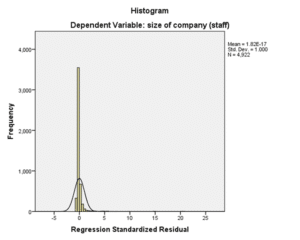
Figure 15 Histogram
(Source : SPSS)
4. Discussion and conclusions
In this review , the research describes the ability of a developed process and the assumption also leads quickly and the response should be accurate. Use hierarchical products including representations and external information and external information by promoting the culture of the organization which should make a step forward in the progress of the organization.Taking into account of the customers needs for the future and assumptions are exceptional fundamental to the business which make all the business to make some growth in teh future. It will generate some new ideas in the business for some progress. The ability of the entire agency to innovate is largely based on the imagination of teh people ,the consequences of the examination show the innovation of employees and firmly align with the culture of the development support of teh organization.
Developing CreativeProtection’s corporate culture is an important way to further develop an insurance agent’s ability to advance. Social development platform insurance agency requires first agreement on leadership, on this premise,to adopt a sound strategy for planning and consolidation. In the new business environment, the usual construction of the alignment of the pyramids of defense efforts due to the inhibition of advancement and change. The guard change model of link is interactive; In adventure, the plan emphasizes the loyalty and solidarity of the cycles of the association. the consequence is it impacts the culture of the association that supports to advance, makes a difference to work on coordination between utility agencies in the department, it assumes an important part is having the right environment that promotes advancement by finding open doors for innovation from the outside to turn them into effective promotion .Along with the research the promotion ability is one of teh most desirable element that directors need to cultivate.Along with these lines, the promotion ability is one of the most desirable elements that directors need to cultivate. This accommodation controlling impulse empowers and certifies people for development. This will help link with super driving previous factors, administration and action plans.
References list
Bouzarovski, S. and Haarstad, H., 2019. Rescaling low‐carbon transformations: Towards a relational ontology. Transactions of the Institute of British Geographers, 44(2), pp.256-269.
Geels, F.W., 2018. Disruption and low-carbon system transformation: Progress and new challenges in socio-technical transitions research and the Multi-Level Perspective. Energy Research & Social Science, 37, pp.224-231.
Geels, F.W., 2018. Low-carbon transition via system reconfiguration? A socio-technical whole system analysis of passenger mobility in Great Britain (1990–2016). Energy research & social science, 46, pp.86-102.
Geels, F.W., Schwanen, T., Sorrell, S., Jenkins, K. and Sovacool, B.K., 2018. Reducing energy demand through low carbon innovation: A sociotechnical transitions perspective and thirteen research debates. Energy research & social science, 40, pp.23-35.
Hämäläinen, E. and Inkinen, T., 2019. Industrial applications of big data in disruptive innovations supporting environmental reporting. Journal of Industrial Information Integration, 16, p.100105.
Harris, T.M. and Landis, A.E., 2019, March. Space sustainability engineering: Quantitative tools and methods for space applications. In 2019 IEEE Aerospace Conference (pp. 1-6). IEEE.
Heuberger, C.F., Staffell, I., Shah, N. and Mac Dowell, N., 2018. Impact of myopic decision-making and disruptive events in power systems planning. Nature Energy, 3(8), pp.634-640.
Ibáñez, J.J. and Mazzucco, N., 2021. Quantitative use-wear analysis of stone tools: Measuring how the intensity of use affects the identification of the worked material. PloS one, 16(9), p.e0257266.
Johnstone, P. and Kivimaa, P., 2018. Multiple dimensions of disruption, energy transitions and industrial policy. Energy Research & Social Science, 37, pp.260-265.
Kramer, G.J., 2018. Energy scenarios—Exploring disruption and innovation. Energy Research & Social Science, 37, pp.247-250.
Mahoney, J. and Owen, A., 2021. Importing set-theoretic tools into quantitative research: the case of necessary and sufficient conditions. Quality & Quantity, pp.1-22.
Marsden, G., Anable, J., Chatterton, T., Docherty, I., Faulconbridge, J., Murray, L., Roby, H. and Shires, J., 2020. Studying disruptive events: Innovations in behaviour, opportunities for lower carbon transport policy?. Transport Policy, 94, pp.89-101.
Nemet, G.F., 2019. How solar energy became cheap: A model for low-carbon innovation. Routledge.
Sovacool, B.K., Turnheim, B., Martiskainen, M., Brown, D. and Kivimaa, P., 2020. Guides or gatekeepers? Incumbent-oriented transition intermediaries in a low-carbon era. Energy research & social science, 66, p.101490.
Tyfield, D., 2018. Innovating innovation—Disruptive innovation in China and the low-carbon transition of capitalism. Energy Research & Social Science, 37, pp.266-274.
Wilson, C. and Tyfield, D., 2018. Critical perspectives on disruptive innovation and energy transformation. Energy Research & Social Science, 37, pp.211-215.
Wilson, C., 2018. Disruptive low-carbon innovations. Energy Research & Social Science, 37, pp.216-223.
Winskel, M., 2018. Beyond the disruption narrative: Varieties and ambiguities of energy system change. Energy Research & Social Science, 37, pp.232-237.
Know more about UniqueSubmission’s other writing services:


I just could not leave your web site before suggesting that I really enjoyed the standard information a person supply to your visitors? Is gonna be again steadily in order to check up on new posts.
Hi my loved one! I wish to say that this post is amazing, nice written and include approximately all vital infos. I’d like to peer more posts like this.